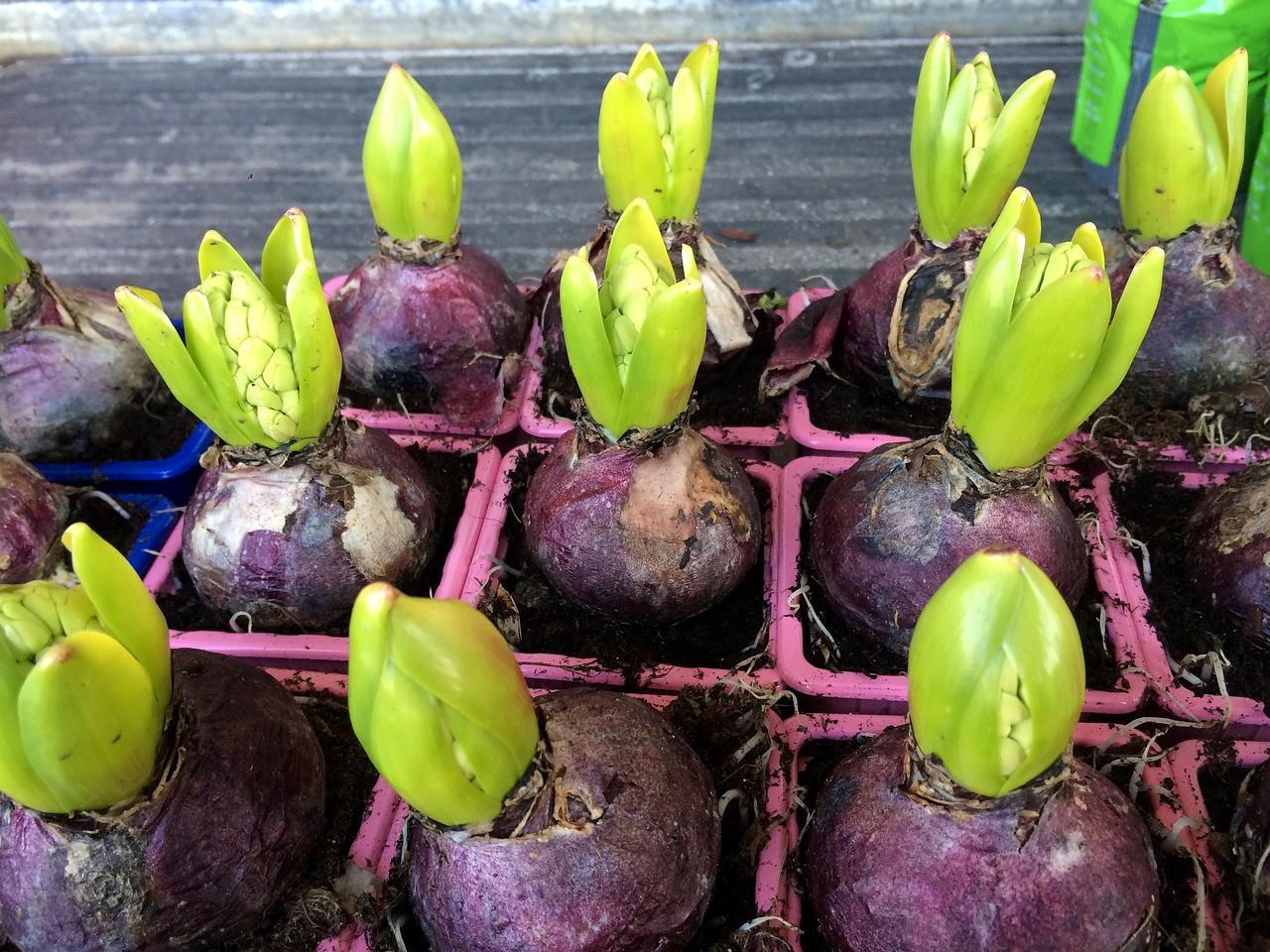Hyacinths, with their vibrant colors and sweet fragrance, are a popular choice for gardens and homes, heralding the arrival of spring. These beautiful flowers, known for their dense clusters of blossoms in shades of purple, blue, pink, white, and yellow, can truly brighten any space. However, if you share your home with a curious cat, you might be wondering: Are Hyacinths Toxic To Cats?
The unfortunate truth is, yes, hyacinths are indeed poisonous to cats. While their beauty might be appealing, it’s crucial for cat owners to understand the risks these plants pose. In this comprehensive guide, we will delve into why hyacinths are toxic to cats, the symptoms of hyacinth poisoning, and most importantly, how to ensure the safety and well-being of your beloved feline companion.
Understanding Hyacinth Toxicity in Cats
 Close up of hyacinth bulbs showing layers and roots
Close up of hyacinth bulbs showing layers and roots
Image Credit: Maria, Pixabay
Hyacinths belong to the Liliaceae family, which includes a number of plants known to be toxic to cats. The primary culprit behind hyacinth poisoning is a toxic substance called lycorine. This alkaloid is concentrated within the plant’s bulb and sap but is present throughout the entire plant, including the flowers, leaves, and stem.
When a cat ingests any part of a hyacinth plant, lycorine can trigger a range of unpleasant and potentially serious symptoms. The severity of the reaction depends on the amount ingested, with the bulb containing the highest concentration of toxins, making it the most dangerous part of the plant. Furthermore, the outer layers of the hyacinth bulb contain insoluble oxalate crystals. These microscopic, needle-shaped crystals can cause immediate pain and irritation in the mouth and throat if a cat attempts to chew on the bulb, further exacerbating the issue.
Symptoms of Hyacinth Poisoning in Cats
If your cat has ingested hyacinth, watch out for the following clinical signs:
- Vomiting: This is a common initial reaction as the cat’s body tries to expel the toxins.
- Diarrhea: Lycorine can irritate the gastrointestinal tract, leading to diarrhea.
- Drooling: Excessive salivation can occur due to the irritant properties of the plant and potential nausea.
- Oral Irritation: Pawing at the face, excessive licking, and redness around the mouth can indicate irritation from oxalate crystals.
- Loss of Appetite: Feeling unwell and gastrointestinal upset can cause a decrease in appetite.
- Lethargy: Your cat may become unusually tired and weak.
- Increased Heart Rate: In more severe cases, hyacinth poisoning can lead to an elevated heart rate.
- Difficulty Breathing: In severe cases, respiratory distress can occur, requiring immediate veterinary attention.
- Tremors and Seizures: Though less common, neurological signs can develop in cases of significant ingestion.
If you observe any of these symptoms in your cat after potential exposure to hyacinths, it is crucial to contact your veterinarian immediately. Prompt veterinary care is essential to manage the poisoning and minimize potential complications. You can also reach out to a pet poison helpline for immediate advice.
Keeping Your Cat Safe from Hyacinth Poisoning
While the toxicity of hyacinths is concerning, it doesn’t necessarily mean you need to completely avoid these beautiful flowers if you are a cat owner. The key is to take preventative measures to ensure your cat cannot access them.
Indoor Hyacinths:
If you wish to keep hyacinths indoors, the safest approach is to prevent your cat from accessing them entirely. Consider these strategies:
- Out of Reach Placement: Place hyacinths in rooms your cat cannot access, or on high shelves or plant stands that are completely out of jumping reach. Remember, cats are agile climbers and jumpers, so truly inaccessible locations are crucial.
- Hanging Planters: Utilize hanging planters to display hyacinths, ensuring they are suspended from the ceiling at a height your cat cannot reach, even with determined leaps.
- Protective Barriers: If you place hyacinths on a table or shelf, consider using physical barriers like clear plastic cloches or wire mesh to prevent your cat from getting close to the plants.
- Be Vigilant with Fallen Blooms and Bulbs: Hyacinth bulbs are particularly attractive to diggers and chewers, and fallen flowers can also be tempting for cats to play with and potentially ingest. Regularly check the area around your hyacinths and promptly remove any fallen plant material.
- Consider Alternatives: The safest option for indoor environments with cats is to choose cat-safe plants altogether.
Outdoor Hyacinths:
If you have hyacinths in your garden and your cat has outdoor access, consider these precautions:
- Supervised Outdoor Time: If possible, supervise your cat when they are outdoors, particularly in areas where hyacinths are planted. This allows you to intervene if you see your cat showing interest in the plants.
- Physical Barriers in the Garden: Use fencing or netting to create a barrier around your hyacinth beds, preventing your cat from accessing them.
- Cat Deterrents: Consider using cat deterrent sprays or motion-activated sprinklers near your hyacinth plants to discourage your cat from approaching those areas.
Image Credit: Sabine Schoenfeld, Shutterstock
Cat-Safe Plant Alternatives to Hyacinths
If you love the idea of bringing greenery and floral beauty into your home but are concerned about hyacinth toxicity, there are numerous stunning and non-toxic plant alternatives that are perfectly safe for cats. You can enjoy the beauty of plants without compromising your cat’s health. Here are a few excellent options:
- Gloxinia: These vibrant flowering plants offer a similar colorful display to hyacinths and are considered safe for cats.
- African Violets: Known for their velvety leaves and delicate blooms, African violets are a classic and cat-friendly choice.
- Orchids: Many orchid varieties are non-toxic to cats and bring an elegant touch to any indoor space.
- Boston Ferns: These lush ferns provide beautiful greenery and are safe for feline companions.
- Polka Dot Plants: With their speckled leaves in pink, red, or white, polka dot plants add visual interest and are cat-safe.
- Bromeliads: These striking tropical plants come in various colors and forms and are generally considered non-toxic to cats.
- Prayer Plants: Known for their fascinating leaf movements, prayer plants are safe and add a unique element to your plant collection.
- Spider Plants: Easy to care for and air-purifying, spider plants are a popular and safe option for cat households.
This list is just a starting point. Always double-check the toxicity of any plant before bringing it into your home if you have cats. Reputable sources like the ASPCA website offer comprehensive lists of toxic and non-toxic plants for pets.
Final Thoughts on Hyacinths and Cat Safety
While hyacinths are undeniably beautiful and fragrant flowers, their toxicity to cats necessitates caution for pet owners. By understanding the risks, taking preventative measures, and considering cat-safe plant alternatives, you can create a home environment that is both beautiful and safe for your feline friend. Prioritizing your cat’s well-being ensures you can enjoy the beauty of nature responsibly and without worry. When in doubt about a plant’s safety, always err on the side of caution and choose non-toxic options to protect your beloved cat.
See also:
Sources:
- ASPCA Toxic and Non-Toxic Plant List: https://www.aspca.org/pet-care/animal-poison-control/cats-plant-list
- Pet Poison Helpline: https://www.petpoisonhelpline.com/

